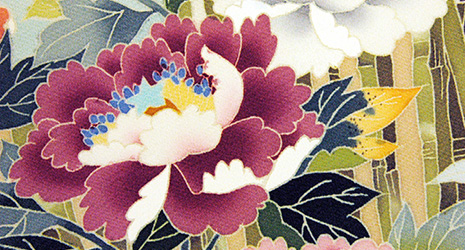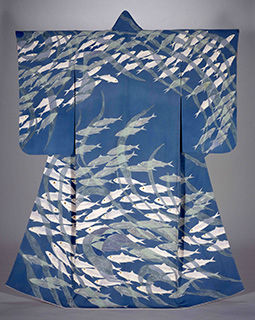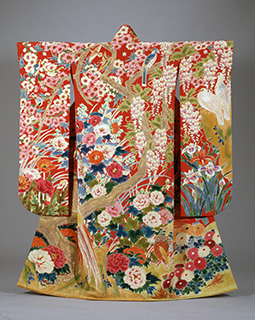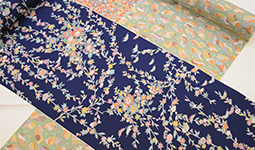December 2022
- English
- 日本語
Kaga-yuzen: Kimono Fabrics Expressing Traditions and Artistic Skill

A mushi-kui pattern, including diseased leaves as an accent (the yellow leaf center right) 
A soto-bokashi pattern, in which flower petals are drawn with different shades of color

A formal yuzen dyed kimono called “A school of fish” (by Kimura Uzan) (Collection of the Ishikawa Prefectural Museum of Art) 
A yuzen dyed furisode long-sleeved robe decorated with auspicious motifs (by Kimura Uzan) Collection of the Ishikawa Prefectural Museum of Art) 
A fan pattern made using the itaba yuzen technique

Kaga-yuzen is a traditional kimono dyeing method that developed in Kanazawa City and surrounding areas in Ishikawa Prefecture and which is characterized by realistic patterns featuring mainly natural motifs such as flowers and grass.

Kaga-yuzen is a colorful method for dyeing kimono that originated in Kaga Province, modern-day Ishikawa Prefecture. Grass, flowers, birds, and other natural scenes are colored on beautiful, lustrous silk fabric using a hake and other brushes.
Nakagawa Seishi of the Kaga Zome Promotion Cooperative Association says that “by the latter half of the 16th century, a dyeing method known as ume-zome was established in Kanazawa. With this method, fabric was dyed using a coloring solution made from the bark or roots of plum trees. Having moved to Kanazawa in 1712, Miyazaki Yuzensai (1654–1736), a fan-painting artist who contributed to the development Kyo-yuzen in Kyoto, added new features to this technique, and Kaga-yuzen flourished and became established in the samurai culture of the Kaga clan.”
Kaga-yuzen emphasizes the Kaga-gosai, or the five Kaga colors of indigo, dark crimson, yellow ocher, grass green, and ancient purple, and it depicts flowers realistically. One characteristic of the dyeing method is coloring by heavy use of a bokashi shading technique to create a three-dimensional effect. Another characteristic is the use of mushi-kui, which depicts diseased leaves* as an accent.


Nakagawa says that “compared to dazzling Kyo-yuzen, Kaga-yuzen is said to have a relaxed grace. You might say that the climate of the region is reflected in the patterns and use of color.”
There are two types of Kaga-yuzen: tegaki yuzen and itaba yuzen. Tegaki yuzen produces realistic, hand-drawn grass, flowers, and other scenes of nature on silk kimono fabric. Itaba yuzen, on the other hand, affixes fabric over a long plate and dyes the fabric using stencils which have been cut into patterns (see here). As it uses stencils, a characteristic of this method is that it allows the same pattern, such as fans and flowers, to be depicted repeatedly without a break.

Hand-drawn tegaki yuzen fabrics in particular strongly express the individuality of the artist. One such artist was Kimura Uzan (1891–1977), whose techniques and patterns greatly influenced the artists that followed. Having studied traditional color schemes and calligraphy from a Japanese painter who was also the master of his brother, Kimura sketched out flowers as well as birds, fish in the market, and other familiar things in the sketchbook he carried while walking around Kanazawa, and he used these as patterns in his yuzen. He created works with motifs of the natural beauty he saw in his everyday life by applying the techniques of Japanese painting, and elevated yuzen to art. In 1955, Kimura was recognized as an Important Intangible Cultural Property (yuzen), also known as a Living National Treasure, in recognition of this.
Nakagawa says, “Influenced by Kimura Uzan, many current Kaga-yuzen artists study Japanese painting and draw patterns just like a painting using kimono fabric as a canvas. This is significant because the Kaga-yuzen processes, involving the designing and coloring of kimono, are handled by a single artist.”
Continuing from their influential originator Miyazaki Yuzensai, Kaga-yuzen kimono fabrics to this day express the beauty of silk-dyeing through the artists who create them, drawing on more than 300 years of tradition.

- * Leaves that are discolored due to insect damage or disease

